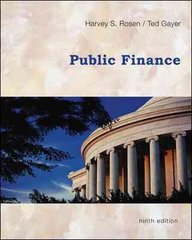To work this problem, youll need a calculator that can take logarithms or a spreadsheet program. Suppose
Question:
To work this problem, you’ll need a calculator that can take logarithms or a spreadsheet program. Suppose that your utility function is U = ln(4 I ), where I is the amount of income you make in a given year. Suppose that you typically make $30,000 per year, but there is a 5 percent chance that, in the next year, you will get sick and lose $20,000 in income due to medical costs.
a. What is your expected utility if you do not have insurance to protect against this adverse event?
b. Suppose you can buy insurance that will cover your losses if you get sick. What would be the actuarially fair premium? What is your expected utility if you buy the insurance policy?
c. What is the most that you’d be willing to pay for this policy?
*8. Suppose that your city government is interested in reducing littering. Currently, there is a $100 fine for littering and there is a 10 percent probability of being caught if you litter. The city is deciding between two different policies: (1) It can increase the number of police that monitor littering, which would make the probability of being caught if you litter 20 percent rather than 10 percent; or (2) it can keep the monitoring the same yet raise the fine for littering from
$100 to $200. (Notice that both policies have the same expected cost of littering.) If litterers are risk averse, which policy would lead to a larger reduction in littering? What if litterers are risk loving (that is, they have a concave utility function, and so prefer an uncertain outcome to the certain outcome with the same expected value)?
Step by Step Answer:






